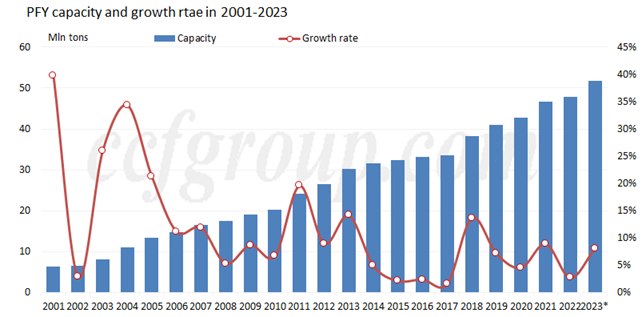Current position and future prospect of polyester filament yarn market
Since that first set of melt-spun filament yarn unit was put into production, China's polyester filament yarn industry has been developing rapidly for more than 20 year, and its capacity has accounted for nearly 80% of the global market share. In the past 20 years, the development of PFY industry has experienced several cycles, and the industrial pattern is also changing constantly.
In 2001-2007, with the localization of polyester industry and the rapid development of China's economy, massive private enterprises entered the PFY industry, and the capacity expanded rapidly, with the average growth rate exceeding 20%.
In 2008-2009, the financial crisis broke out, and the expansion of capacity slowed down by stages. A few enterprises, such as Shaoxing Zongheng, were shuffled out. However, some individual excellent PFY enterprises began to expand against the trend, expanding their market share.
In 2010-2013, after the global large-scale rescue, the PFY industry ushered in the second round of high-speed expansion, with an average capacity growth rate of more than 10%. At this stage, the PFY industry once again ushered in the era of national expansion.
In 2014-2016, global demand weakened, the industry saw periodic overcapacity. The second round of industry reshuffle appeared, and part of private enterprises just expanded capacity were eliminated due to capital chain problems, such as Jiaxing Longteng, Taicang Minghui and Xiaoshan Hongjian, etc. At this stage, the pattern of the industry began to change, and the status of the leading enterprises was formally established.
In 2017-2023, the PFY industry entered into structural expansion. Leading enterprises continued to accelerate the expansion, including restructuring of new production capacity, and capacity concentration ratio further improved as a result. Some old and small-and-medium-sized enterprises were active or passive in withdrawing from the market, such as Zhenhui and Yingxiang etc.
Starting from 2024, the capacity expansion cycle of PFY industry will end, and the capacity growth rate is expected to be low. This round of low capacity growth may last longer than previous rounds. Leading enterprises slow down expansion and small and medium-sized enterprises continue to withdraw.

Standing at the current position, it is believed that this round of PFY expansion cycle has ended, and the growth rate of capacity is anticipated to be low later. The duration of this round of low capacity growth may be longer than that of previous rounds. The expansion of leading enterprises is expected to slow down, and small and medium-sized enterprises will continue to withdraw.
Downstream demand for PFY is estimated to slowly bottom out. After the epidemic backlog demand concentrated release in 2023, domestic demand for textiles and apparels is expected to see moderate slowdown in 2024, but the resilience is still in supported by policies; Export is waiting for overseas replenishment to come, which is optimistically expected to appear in Q2 2024 the earliest. If the overseas consumption keeps falling, the replenishment may appear later. In the future, it is necessary to focus on the repair of profits on PFY downstream market. Only when the profits on downstream sector are repaired, the price and profit tenacity of PFY market will be obvious.
Based on the background of orders transferring to Southeast Asia, the future export will still show structural differentiation. That is, the export of chemical fiber, especially the export of PFY with price advantage, will be better than the export of fabrics and garments. However, it is necessary to pay attention to the anti-dumping on Chinese PFY and the later progress of India's BIS certification.
From the perspective of profit distribution of the industrial chain, PX ends the expansion cycle before PTA and polyester markets, and the profit distribution of the industrial chain will still be biased towards PX link, but the benefit may fall moderately compared with the high level in 2023. PTA is still in the expansion cycle, industry reshuffle will continue and the benefit is expected to remain low. Polyester market is in a structural expansion cycle. Among which, the expansion of PFY will end, coupled with slowly rising end-user demand, the benefit of PFY market is expected to continue to rise; however, PET bottle chip market is under large-scale expansion, and the profit is estimated to keep reducing.
- Top keywords
- Cotton Price
- Cotton Futures Price
- Cotton Futures
- CZCE
- PTA Futures Price
- Chemical Fiber
- Polyester Prices
- Wool price
- PTA Futures
- Shengze Silk
- China
- Yarn Price
- price
- China Textile City
- Fibre Price
- Benzene Price
- Cotton
- Index
- Cotton Index
- PTA
- fabric price
- NYMEX
- Top 10
- textile industry
- Spot Cotton
- Cotton Yarn
- Polyester Price
- Futures
- PTA Price
- cotton yarn price

